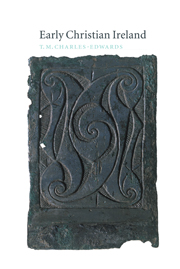Book contents
- Frontmatter
- Contents
- List of maps
- List of tables
- List of figures
- Acknowledgements
- Abbreviations
- A note on pronunciation
- A note on the Chronicle of Ireland
- Introduction
- 1 Ireland in the seventh century: a tour
- 2 Irish society c. 700: I. Communities
- 3 Irish society c. 700: II Social distinctions and moral values
- 4 Ireland and Rome
- 5 Conversion to Christianity
- 6 The organisation of the early Irish Church
- 7 Columba, Iona and Lindisfarne
- 8 Columbanus and his disciples
- 9 The Paschal controversy
- 10 The primatial claims of Armagh, Kildare and Canterbury
- 11 The origins and rise of the Uí Néill
- 12 The kingship of Tara
- 13 The powers of kings
- 14 Conclusion
- Appendix: genealogies and king-lists
- Glossary: Irish and Latin
- Bibliography
- Index
5 - Conversion to Christianity
Published online by Cambridge University Press: 11 September 2009
- Frontmatter
- Contents
- List of maps
- List of tables
- List of figures
- Acknowledgements
- Abbreviations
- A note on pronunciation
- A note on the Chronicle of Ireland
- Introduction
- 1 Ireland in the seventh century: a tour
- 2 Irish society c. 700: I. Communities
- 3 Irish society c. 700: II Social distinctions and moral values
- 4 Ireland and Rome
- 5 Conversion to Christianity
- 6 The organisation of the early Irish Church
- 7 Columba, Iona and Lindisfarne
- 8 Columbanus and his disciples
- 9 The Paschal controversy
- 10 The primatial claims of Armagh, Kildare and Canterbury
- 11 The origins and rise of the Uí Néill
- 12 The kingship of Tara
- 13 The powers of kings
- 14 Conclusion
- Appendix: genealogies and king-lists
- Glossary: Irish and Latin
- Bibliography
- Index
Summary
Early in the fifth century there were already Irish Christians. We know of them because they were one reason for the first known mission to a country beyond the frontier of the Western Roman Empire. In 431 Palladius, a deacon, perhaps of the church of Auxerre, was consecrated bishop and sent to Ireland by Pope Celestine. When, in the early seventh century, the Irishman Columbanus had occasion to write to Pope Boniface, he recalled this Roman mission to his na tive island:
For all we Irish, inhabitants of the world's edge, are disciples of Saints Peter and Paul and of all the disciples who, by the Holy Spirit, wrote the divine scripture, and we accept nothing outside the evangelical and apostolic teaching; not one has been a heretic, not one a Judaiser, not one a schismatic, but the Catholic Faith as it was given to us first by you, that is the successors of the holy apostles, is preserved intact.
More than a century later, the Northumbrian historian Bede also remembered Palladius as the first missionary bishop of the Irish. One tradition about the conversion of the Irish was therefore centred upon this man sent to Ireland by the bishop of Rome.
For most men, however, from the seventh century, the apostle of the Irish was the Briton, Patrick. A hymn composed in his honour, possib lyabout, described him as the Irish St Peter, the chief apostle of the country.
- Type
- Chapter
- Information
- Early Christian Ireland , pp. 182 - 240Publisher: Cambridge University PressPrint publication year: 2000



